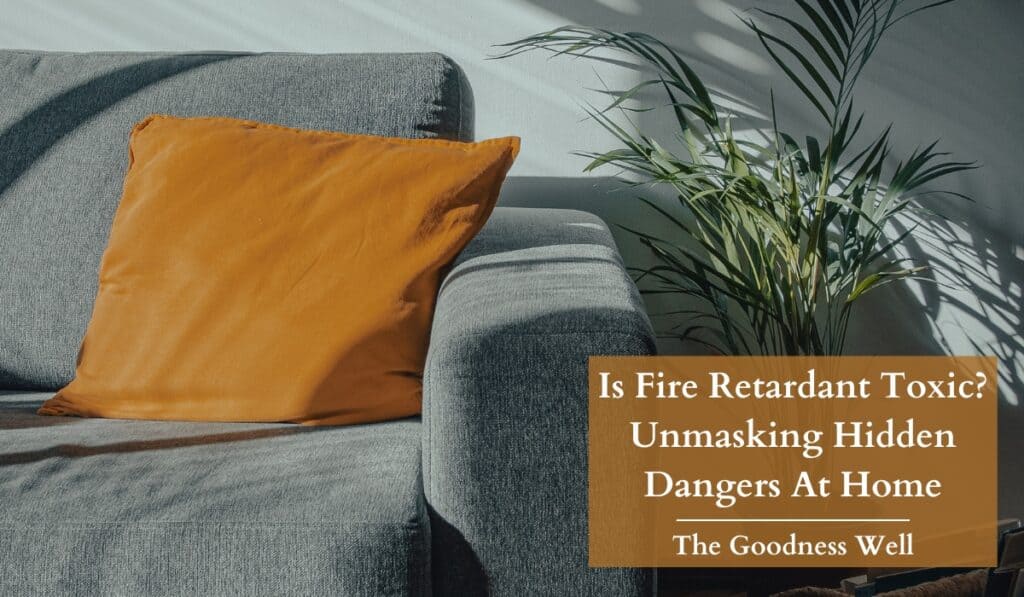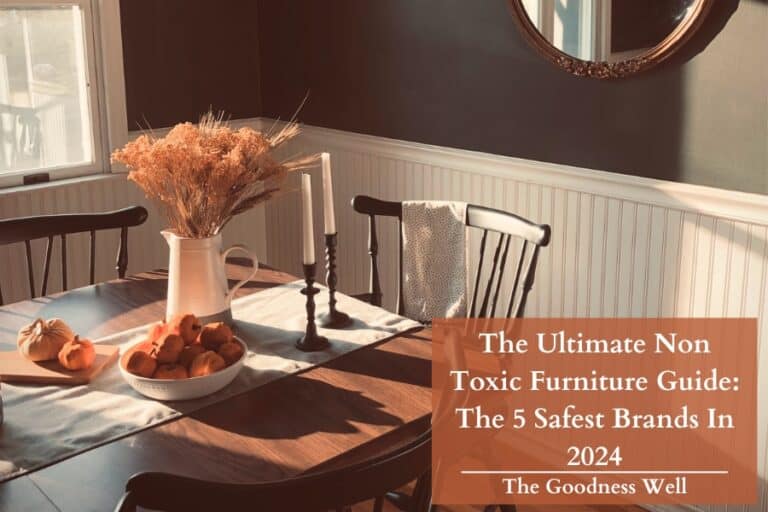Is Fire Retardant Toxic? Hidden Dangers at Home

Is fire retardant toxic? From the sound of it, at the very least it sounds like something meant to keep us safe…
…But that couldn’t be further from the truth.
Although flame retardants were originally created with the good intention of keeping consumers safe, they expose you and me to harmful toxins, some even known to be carcinogenic.
There’s evidence suggesting flame retardants are harmful to our health and the environment.
Let’s get into how unsafe flame retardants are, what makes them so harmful, and how you can reduce your exposure.
🔥TL;DR:
Are fire retardants toxic?
Fire retardants aren’t safe because of the chemicals they contain.
Many of these chemicals are designed to resist heat and slow the spread of fire, but this can also mean they’re super persistent in the environment and within us😳.
When these chemicals are released, either during a fire or as the products off-gass over time, they can be inhaled, ingested, or absorbed through the skin.
Fire retardants include brominated or chlorinated compounds (aka carcinogenic organic compounds), which are harmful because they can accumulate causing hormone disruption nervous system damage, and negative effects on reproductive health.
What are Flame Retardants?
Flame retardants are a set of chemicals used in various products to slow the spread of fire.
Back in the ’50s, when folks were all about those new synthetic materials, they realized how flammable it was. So, they started adding chemicals like chlorinated and brominated compounds to keep things from catching and spreading fire too easily.
Fast forward to the ’70s and ’90s, and these chemicals were everywhere – in kids’ clothes, your couch, the TV, you name it.
In 1975, California passed a regulation called Technical Bulletin 117, or TB 117, which required all upholstered furniture sold within the state to contain flame-retardant chemicals.
But then, by the late ’90s and into the 2000s, scientists started finding out that some of these chemicals, especially those PBDEs (Polybrominated Diphenyl Ethers ), weren’t too great for our health.
This led to fire retardants being phased out and even banned in some places. Unfortunately, a lot of products still contain these chemicals, especially ones a bit older.
Where Is It Found?
Here are some products they are commonly found in:
- Sofas
- Couches
- Mattresses
- Pillows
- Car seats
- Clothing
- Carpets and curtains
- Electronics
- Children’s clothing and toys
How Harmful Are They?
Different types of flame retardants according to the NIEHS, are linked to a variety of negative health effects:
| Type of Fire Retardant | Health Concerns |
|---|---|
| Hexabromocyclododecane (HBCD) | Linked to endocrine disruption, neurotoxicity, and immune and reproductive changes. |
| Brominated Flame Retardants (BFRs) | Linked to endocrine and thyroid disruption. |
| Organophosphate Flame Retardants (OPFRs) | Could pose risks to bone and brain health. |
| Tetrabromobisphenol A (TBBPA) | Linked to neurotoxicity, immune toxicity, and cytotoxicity. Also listed on California’s Prop 65 list. This fire retardant was made as a replacement for PBDEs. |
| Polybrominated Diphenyl Ethers (PBDEs) | Can cause neurodevelopmental disorders. Despite being phased out in 2004, they still exist in certain items. |
“Wait, but I’m not eating my couch or TV, so how can flame retardants affect me?” 🤔
Lol that was a joke…
Anywho, flame retardants in furniture or electronics don’t stay put.
They escape into the air and dust around us, which we breathe in. They also seep into our air, water, and soil during production.
The worst part about it is that our children are even more at risk than we are…
Is Fire Retardant Unsafe for Children?
Children tend to play on the rugs and carpets where dust settles and where their risk of exposure is highest.
They also breathe more air relative to their body size compared to adults, taking in more potentially contaminated dust.
And on top of that, their bodies are still developing, making them more vulnerable to the potential health effects of these chemicals.

Exposure can even occur through breastfeeding, as certain flame retardants have been found in breast milk.
Research has suggested flame retardants may have negative effects on fetal development and children’s cognitive and behavioral development.
Is Fire Retardant Carcinogenic?
The NIEHS has reported that certain types of flame retardants, such as PBDEs, have been linked to increased cancer risk.
Although PBDEs have been phased out of a lot of products, they have been replaced by another similar fire retardant called TBBPA(Tetrabromobisphenol A), which is just as harmful. 👎🏽
A study from Environmental Health Perspectives research, highlights the effects of TBBPA and other BFRs, showing that they can mimic estrogen and potentially contribute to tumor growth.
Furthermore, the study reveals that even small amounts of various BFRs can disrupt our hormones, which is associated with a range of health risks, including cancer and reproductive problems.
Final Thoughts
So, is fire retardant toxic? Yes, fire retardant is harmful to human health and the environment.
They’ve been associated with endocrine disruption, neurotoxicity, reproductive challenges, and cancer.
But there are ways to avoid and reduce your exposure to these chemicals.
While we can’t totally eliminate fire retardants from our lives, we can follow certain guidelines and get rid of items that could increase our risk of exposure.
Frequently Asked Questions
Nope. Flame retardants are more typically found in clothing specifically designed for high-risk environments such as firefighting gear and certain uniforms.
Although, some loose-fitting clothes like children’s pajamas do contain fire retardants.
However, in general everyday clothing, flame retardants are not usually used.
Fireproof spray can be toxic, depending on its chemical composition.
Many fireproof sprays contain chemicals that are effective in resisting fire but release toxic fumes when heated or during application.
To protect yourself from flame retardants, choose products that are labeled as free from chemicals used in fire retardants.
Regularly cleaning dust, and using a vacuum with a HEPA filter can minimize your exposure.
Because they are harder to break down, they persist in soil and water, building up in wildlife and disrupting ecosystems.
These chemicals can climb up the food chain, leading to health issues in wildlife, and are also released into the air and water through manufacturing, use, and disposal.






